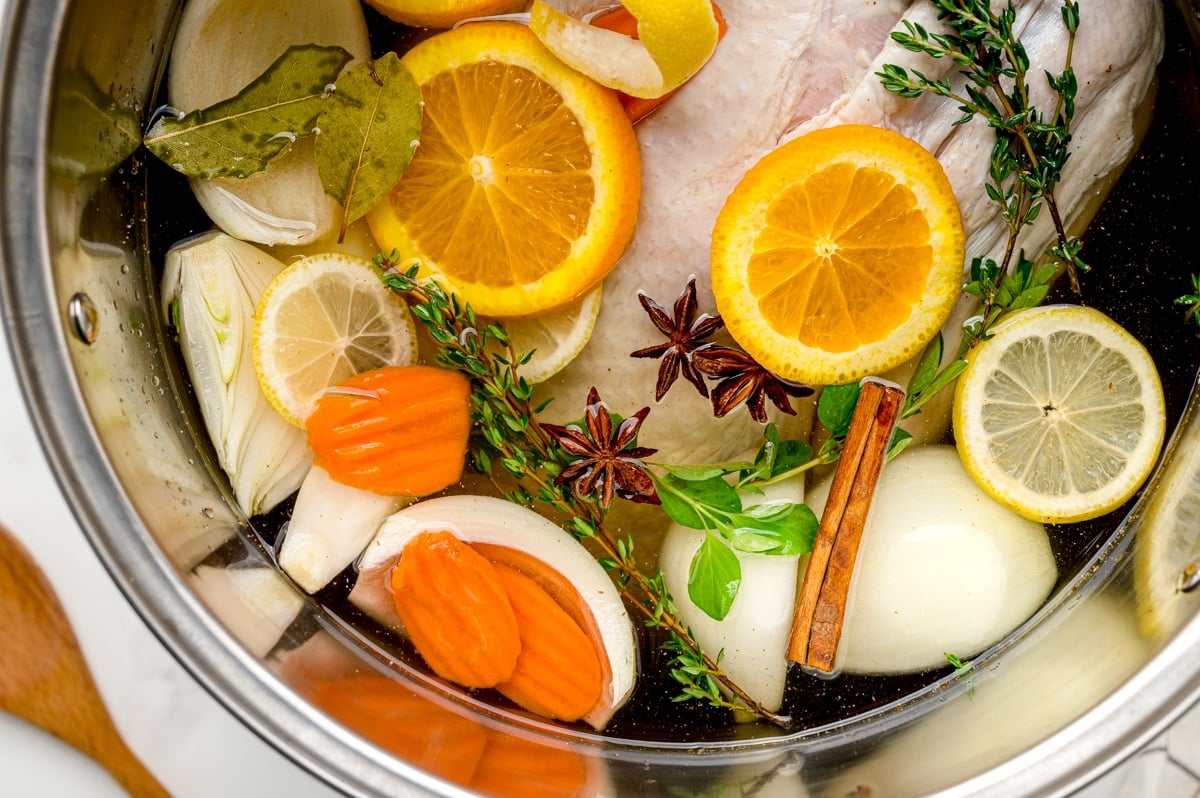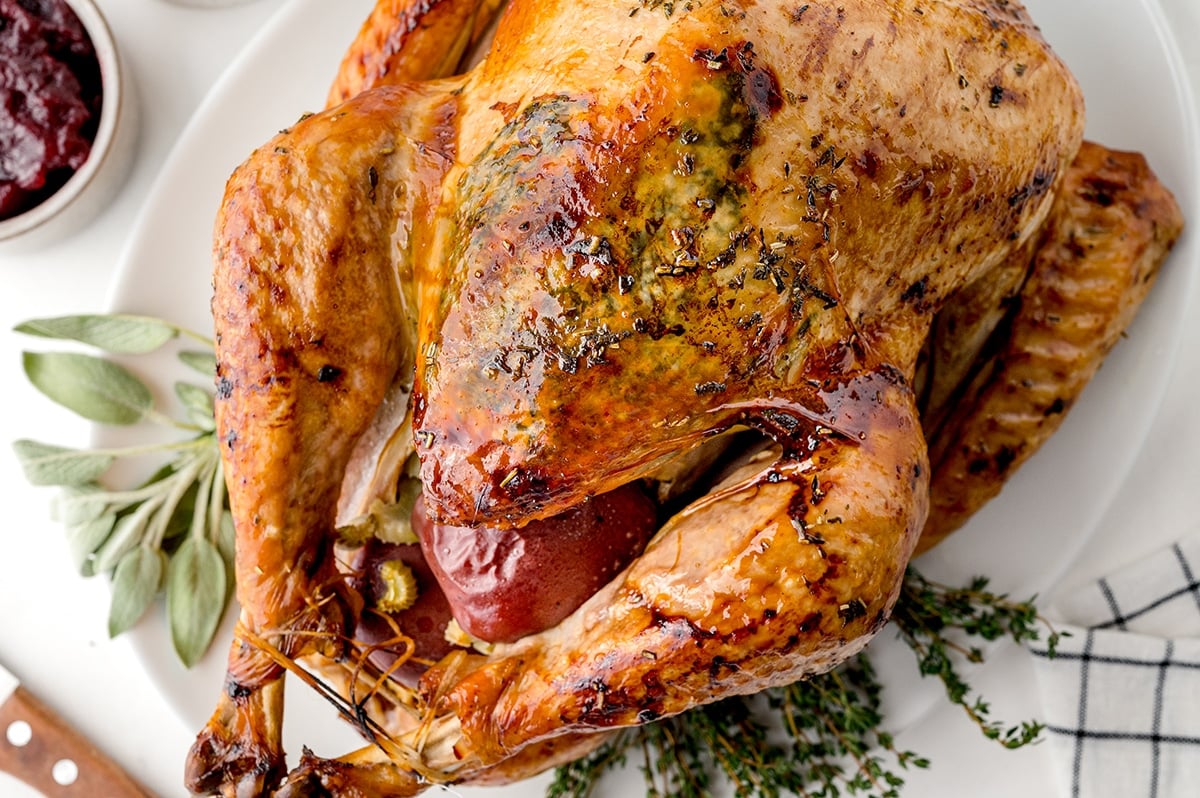Thanksgiving turkey recipes have sure come a long way. Thanksgiving dinner, in general, has come a long way!.
A basic brine for turkey can be as simple as dissolving salt in water, or it can be as complex as letting the brine steep in herbs for two days and then letting it air dry to achieve the ideal crispy skin.
I believe it’s worth it to brine a turkey, and I know a lot of other people feel the same way. Although there are many ways to keep your turkey juicy and flavorful, brining is arguably the most effective method. It enhances the flavor of the skin on the bone; neither a rub nor an injection can do that.
While the provided recipe uses table salt for brining the turkey, it’s important to note that using table salt for brining is not recommended.
Here’s why:
- Table salt contains iodine and anti-caking agents, which can affect the flavor and texture of the turkey.
- Kosher salt, on the other hand, is pure sodium chloride and does not contain these additives. This makes it the preferred choice for brining.
However, if you only have table salt available, you can still use it for brining. Just keep in mind the following:
- Use a slightly smaller amount of table salt than the recipe calls for. This is because table salt is denser than kosher salt.
- Dissolve the salt completely in the water before adding the turkey. This will help ensure that the salt is evenly distributed throughout the brine.
- Be aware that the turkey may be slightly saltier than if you had used kosher salt.
Here are some additional tips for brining a turkey:
- Use a large container that is non-reactive, such as a stainless steel pot or a food-grade plastic container.
- Make sure the turkey is completely submerged in the brine.
- Refrigerate the turkey while it is brining.
- Brine the turkey for at least 12 hours, but no more than 24 hours.
- Rinse the turkey thoroughly before roasting.
By following these tips, you can use table salt to brine a turkey and still achieve delicious results.
Best Turkey Recipe
Here is the “Best Turkey Ever!! (Brined)” recipe from Food,com:
Ingredients:
- 15 lbs turkey (not self-basting or kosher)
- 2 cups table salt (do not substitute equal amounts of kosher salt)
- 2 gallons icy cold water
- 4 cups brown sugar
- 1/2 cup dried rosemary leaves
- 1/2 cup dried thyme leaves
- 1 small onion, peeled and quartered
- 1 carrot, peeled & cut into 1-inch chunks
- 1 stalk celery, cut into 1-inch chunks
- 4-6 tablespoons unsalted butter, melted
- Fresh fruit (to garnish)
Instructions:
- Rinse turkey in cool water.
- In a large clean container, mix salt and water together until salt dissolves. Stir in brown sugar and spices, mix well until sugar dissolves.
- Totally submerge poultry in solution and store, covered, in refrigerator for at least 6 hours and up to 8 hours. Since brining does not preserve meat, the turkey must be kept below 40 degrees F throughout the entire brining process. Ice packs may also be used to keep turkey at a safe temperature of below 40°F.
- Remove turkey from brine. Discard brine. Thoroughly rinse turkey under a slow stream of cool water, rubbing gently to release salt and sugar, both inside and out. Pat skin and both interior cavities dry.
- In the cavity of turkey, place onion, carrot and celery.
- Brush turkey with melted butter.
- Roast turkey, breast side down, in a preheated 325 degree F oven for 2 hours. During this time, baste legs and back twice with melted butter.
- Remove turkey from oven and protecting your hands, grasp turkey with several layers of clean paper towels at both ends, and turn turkey, breast side up.
- Return turkey to oven and continue to roast, basting twice with pan dripping. Continue to roast until internal temperature reaches 170°F in the breast and 180°F in the thigh. NOTE: A brined turkey cooks slightly faster than an unbrined turkey, so check the internal temperature frequently.
- Remove turkey from the oven and allow to stand for 20 minutes before carving.
- Transfer to a platter and garnish with fresh fruit.
Frequently Asked Questions
Can I use table salt to brine a turkey?
Yes, you can use table salt to brine a turkey, but it is not recommended. Table salt contains iodine and anti-caking agents, which can affect the flavor and texture of the turkey. Kosher salt is the preferred choice for brining because it is pure sodium chloride and does not contain these additives.
How long should I brine a turkey?
You should brine a turkey for at least 12 hours, but no more than 24 hours.
What is the best temperature to roast a turkey?
The best temperature to roast a turkey is 325 degrees F.
How long should I roast a turkey?
The roasting time for a turkey will vary depending on the size of the turkey. A general rule of thumb is to roast the turkey for 13 minutes per pound.
How do I know when the turkey is done?
The turkey is done when the internal temperature reaches 170°F in the breast and 180°F in the thigh.
What should I do with the leftover turkey?
Leftover turkey can be used in a variety of dishes, such as sandwiches, soups, and casseroles.
Brining a turkey is a great way to ensure that it is moist and flavorful. While using table salt for brining is not recommended, you can still use it if you only have table salt available. Just keep in mind the tips mentioned above.
Additional Resources
Turkey Brine Recipe Simple tips
- Wet Brine. This technique is called wet brining. Your turkey will absorb nearly a pound of moisture from a wet brine, which is added to a 12-pound bird. The only drawback to wet brining a turkey is that the skin won’t get crispy, but we’ve got a fix for that below. You can learn more about a dry brines too.
- Use Large Grain Salt. Not all salt is created equal. Salts differ in size, shape, flavor, chemical makeup, ability to dissolve (though they all do so eventually), and ability to dissolve, which all contribute to their different densities. A tablespoon of table salt and a tablespoon of Kosher salt are not the same thing. To get the right salt to water ratio for brine, use larger-crystal Kosher salt—one heaping tablespoon for every cup of water or one cup for every gallon of water.

- Add flavor. There are countless flavors you can incorporate into your simple brine. You can use boiling water to infuse water with more flavor, but for a basic brine recipe that just calls for salt and water, boiling is not necessary because the salt will dissolve anyhow.
- How Make the Crispiest Turkey Skin. Brining prevents browned, crispy skin by adding a lot of moisture and flavor while also making the skin extremely wet. To achieve the best of both worlds, brine your turkey for a full day, then take it out of the brine and let it dry out in the fridge for a further day without covering it. If you’re pressed for time, just use paper towels to dab dry.
- How to make turkey stock. And when you’re all done, save the bones to make the easiest and tastiest leftover recipe—turkey stock and turkey noodle soup!
Turkey Brine vs. Rub vs. Injection
The newest turkey trends: is it just me, or did brining a turkey not become a “thing” until a few years ago? What will be next?.
- Turkey Rub: Excellent for seasoning the skin of the bird without requiring it to marinate Just rub and go.
- Turkey Injection: Not recommended for use with brining, but it can be used with the rub You literally inject liquid into the turkey. No need to let it sit. Create pockets of flavor and moisture.
- The ultimate turkey preparation method is brining, but it also needs some advance planning. It adds flavor and moisture to every fiber of the turkey, but it also requires a lot of room and at least 24 hours.
Following any of these methods, you have the option to roast, fry, or smoke the bird.

